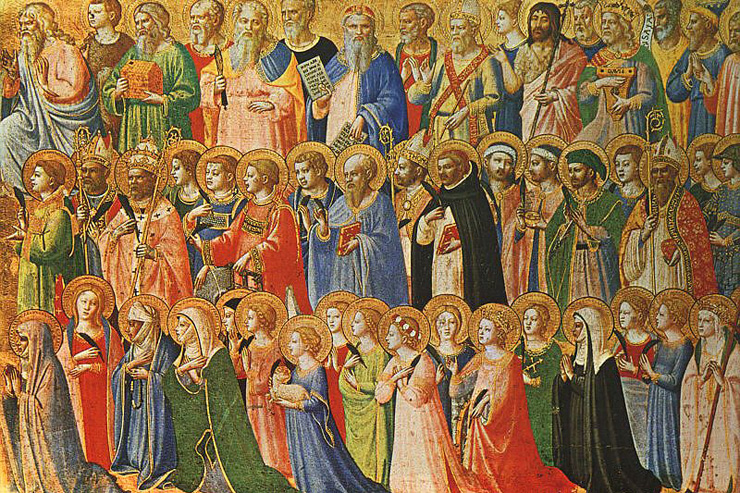When I was a Protestant I wondered why Catholics had so many statues of saints in their churches. There were two problems. First, I had been raised to believe that carved images were wrong because they broke the commandment “you shall not make to yourself any graven image.” Second, I was told that Catholics worshipped the saints, and sure enough, when I went into a Catholic church I saw people kneeling down and praying in front of the statues.
As I moved into the Catholic Church I studied the question of images. The argument had been around for a long time, but it came to a climax in the eighth century with the “iconoclasm controversy”. “Iconoclasm means “breaking of images”. At that time some leaders of the churches in the East argued that Christians should not use any carved or even painted images in worship. Those in favor of icons said they were permissible for a very interesting reason. Jesus Christ, they argued, was the image (“icon” means image) of the unseen God. They drew this idea from St Paul’s words in Colossians 1:15.
Before the incarnation God commanded that images could not be made because God was not visible and able to be imagined by man. However, because Jesus was the physical human icon or image of God, it was therefore permissible to create icons of Jesus. Furthermore, every Christian is called to be an image or likeness of Jesus in the world. Saints are ordinary Christians who have been completely fulfilled in Christ. Each saint is a unique image of Christ in the world. Therefore is is also permissible to make images of saints.
This is why we have images of saints — because they are images of Christ. We see Christ alive in them. Pope Benedict said saints are “living theology” and elsewhere he said that we can only interpret the Scriptures through the lives of the saints. In the saints we see the theories of our faith lived out in human history. In the saints we see the truths of Scripture alive in the lives of ordinary people. In the saints we see the grace of God at work in a powerful and real way.
This is why we have images of saints in our churches, and this is why we try to get images which are expertly made and beautifully designed. The images of saints should be the very best we can afford because the fine workmanship and beautiful natural materials in the image reflect the fact that the saint is “God’s handiwork” and the glory of the fine work of art reflects the glory and majesty of the saint God has created.
We venerate the saints because they show us our destiny. Each one of us, by virtue of our baptism and faith in Christ, are called to be complete and whole in Christ. As St Paul says in Ephesians, we are called to “grow up into the full statue of Christ’s humanity” The saints show us what that looks like.
As Catholics we venerate the saints, but we do not worship them. The church distinguishes three levels of veneration with three Greek words. “Latria” is the worship that is due to God alone. This is the worship we offer God through the sacrifice of the Mass and within Eucharistic adoration. “Dulia” is the veneration or honor we give to someone who we greatly admire and respect. This is the veneration we offer to the saints. “Hyperdulia” or “great honor” is the level of veneration and respect we give only to the Virgin Mary — who is the greatest of all created beings. The church teaches that the Blessed Virgin is greater even than the angels.
In addition to the honor we offer saints through veneration of their images and relics, we also pray to the saints. This is also confusing to non-Catholic Christians. We always need to make it clear that we do not “pray to the saints” in the same way that we pray to God. The confusion on this matter comes down to a question of language. When we pray to the saints we are using the word “pray” meaning “to ask”. This use of the word can be seen in archaic English usage. So in Shakespeare’s plays a character might say, “I pray you good sir, lend me a ducat.” He uses the word “pray” to mean “to ask.”
So when we pray to saints we are asking them to pray with us and for us in the same way that we might ask a friend, family member or fellow parishioner to pray for us.
In these ways — veneration and prayer to the saints — we live within the communion of saints. Hebrews 12.1 says we are “surrounded by a great cloud of witnesses.” The saints are not dead people. They are alive in Christ and we share our faith with them and they share their faith and their prayers with us.
On this earth we are most closely united with the saints at the celebration of the Eucharist. I once went to visit an old priest named Fr. Richard who celebrated Mass early every morning.
“Were there many at Mass this morning Father?” I asked, making conversation.
His old eyes twinkled, “Oh yes! Millions! But I could only see three of them.”
He was referring to the “great cloud of witnesses” who worship with us every time we approach the altar of God.
The great cloud of witnesses is the saints of God. We must remember that the saints are not only those who the church has formally recognized as saints. There are multitudes more who have followed the path of perfection but not been formally recognized here on earth. At Mass we are one with them as together we join our lives with the life of Christ the Lord.
If you liked this article, please share it with your friends and family using both the Recommend and Social Media buttons below and via email. We value your comments and encourage you to leave your thoughts below. Thank you! – The Editors















